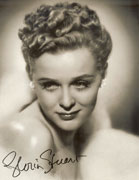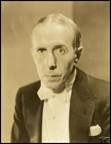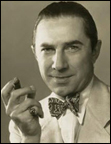Here are 10 things you should know about Lee Patrick, born 122 years ago today. After more than a decade of Broadway success, she became a versatile character actress in films, radio and TV.
Tag: Louella Parsons
10 Things You Should Know About Hedda Hopper
Here are 10 things you should know about Hedda Hopper, born 138 years ago today. She was a stage and film actress for three decades before she became a gossip columnist.
10 Things You Should Know About Mary Astor
Here are 10 things you should know about the versatile Mary Astor, born 116 years ago today. Over the course of a 44-year career, she appeared in more than 120 films and amassed more than 30 television credits.
Remembering Gloria Stuart on Her Birthday
Gloria Stuart was born on Independence Day, 1910, in Santa Monica, California. In 1999, when she was just a kid of 89, we got to interview her on the occasion of the publication of her memoir, I Just Kept Hoping. The interview was conducted over the telephone, though we did get the chance to meet Ms. Stuart when she came to NYC for her book party.

We considered it quite a thrill, we don’t mind telling you, to get to interact with Ms. Stuart. After all, this is the women who starred opposite Claude Rains in James Whale‘s The Invisible Man, who appeared with Boris Karloff, Melvyn Douglas, and Charles Laughton in The Old Dark House, who worked with greats such as Irene Dunne, Ralph Bellamy, Pat O’Brien, Lionel Barrymore, Lee Tracy, Nancy Carroll, Frank Morgan, Paul Lukas, Edward Arnold, Eddie Cantor, Ruth Etting, and dozens more.
So, to celebrate her 111th birthday, we thought we’d share the interview we did with her in 1999. Enjoy!
It’s been a long, eventful life for former and current movie star Gloria Stuart. She had her first go-around at stardom in the Hollywood heyday of the 1930s and ’40s; then, after taking off 30 years or so to pursue painting, travel, and political activism, she again began to act in the 1970s, eventually garnering a Best Supporting Actress nomination for her role in Titanic. Still going strong today at the age of 89, Stuart has now added authorship to her list of achievements. Her candid memoir, I Just Kept Hoping, is peppered with anecdotes about such memorable figures as Shirley Temple, Groucho Marx, Dorothy Parker, and J. Robert Oppenheimer, the father of the atomic bomb. We spoke to Gloria about her life, her two careers in the movies, and her secrets for living so long and so well.
An Interview with Gloria Stuart
You made three films with director James Whale: The Invisible Man, The Old Dark House, and The Kiss Before the Mirror. What can you tell us about him?
I’m very happy I was in those films. You know, James is a cult figure in England. There are a lot of James Whale fan clubs. Actually, right after I had read for Jim Cameron for Titanic, I had booked a month in London. I went right away, and there were two wonderful James Whale organizations that I met with. He’s getting his due now, thanks to Gods and Monsters.
What did you think of Gods and Monsters? Was it, in your view, an accurate portrayal of Whale?
Oh, yes, it was. Ian McKellan captured James’s elegance, the beautiful manners, the beautiful tailoring, the precision, the whole thing. Of course, no one could be James, but he came awfully close.
The special effects in The Invisible Man hold up remarkably well today for a film that was made in 1933.
Yes, people who see it today—it runs every so often—they say, gee, it’s not an old hat movie at all.
I’m wondering—did the processes that went into creating those special effects slow down the pace of moviemaking at all?
It was never evident. Only James and the cameraman and I guess all the process people at Universal—the rest of us never had any inkling of what was going on. We did do a lot of shooting in front of black curtains. Now, I wasn’t on the set when the bandages came off or anything like that, so I have no idea about that. But it was very, very secret. I wasn’t on the set when they were finagling the bandages off, and so forth.
That would’ve been fun to see.
Yes, it would’ve! Claude [Rains] may have known [how it all worked] but he never said so.
You and your second husband, Arthur Sheekman, were good friends with Humphrey Bogart and Mayo Methot, his wife at the time. What can you tell us about Bogie that we might not know?
Read More »
Old news is good news
The term “yesterday’s news” is usually meant to denigrate, but for fans of the Golden Age of Hollywood, old news can often be welcome news. Following, in retrospect, the career ebbs and flows — and even the day-to-day lives — of our favorite performers, writers, and directors offers a new/old insight on these fascinating figures.
A terrific resource for such digging through the past is the very worthy blog Hollywood Heyday. Each entry revisits the Tinseltown news and gossip of a particular day in a given year, leaving the reader feeling as if she’s traveled back in time.
The sources are wire services and syndicated columnists, among them such still-familiar names as Luella Parsons and Hedda Hopper and other journalists whose names are not as well known today, including Wood Soanes and Chester B. Bahn.
 These tidbits provide prose snapshots of a particular time in a movie personality’s life. For example, this snippet from Soanes about comedic character actor Charles Butterworth from April 22, 1932:
These tidbits provide prose snapshots of a particular time in a movie personality’s life. For example, this snippet from Soanes about comedic character actor Charles Butterworth from April 22, 1932:
Charles Butterworth, whose movie career terminated largely because his style of humor is so distinctive that he needed a special author to provide him with material, is returning to the stage for a comedy part in the next Max Gordon revue. Before that happens, however, he’ll work with Chevalier in a picture.
Butterworth was hardly through with the movies at that point in time — he went on to make more than thirty more pictures before his premature death in an auto accident in 1946 — but it’s intriguing to learn that at one point in time, it was thought he was finished in Hollywood.
Other stories remind us that now-familiar names were not always so, as in this tidbit from Bahn on the same date, April 22, 1932:
Universal failed to pick up option of Mickey Rooney, formerly known as Mickey McGuire.
It’s intriguing to think of a time when young Mickey was a) newly dubbed “Rooney” and b) getting dropped by movie studios.
 One also learns of once-highly anticipated projects that never came to fruition, as in this Parsons offering regarding Constance Bennett:
One also learns of once-highly anticipated projects that never came to fruition, as in this Parsons offering regarding Constance Bennett:
“The Sun Also Rises,” to star Constance Bennett, is more than just a mere rumor. The book has been purchased and Rowland Brown is now reading it and discussing treatment, for he will direct her. Some of the considerable angles will have to be removed but it is fundamentally a splendid story and should give Connie an excellent vehicle.
To the best of our knowledge, that’s a project that never got off the ground, but learning that it was once in the works leaves us wondering just how it might have turned out.
 Some of the stories provide a laugh or two, as well, like this one (source unknown):
Some of the stories provide a laugh or two, as well, like this one (source unknown):
Bela Lugosi did a laugh-clown-laugh stunt at the Carthay Circle theater the other night. He tripped back stage, fell and broke three ribs, but went on with his performance of “Murdered Alive.” He probably felt just that way.
Admittedly, few of the reports offered by Hollywood Heyday are major news, even by Tinseltown standards — they merely offer a glimpse of the daily professional and personal ups and downs of fondly remembered (and some not-so-fondly recalled) members of the picture biz of decades past. There are those who would no doubt scratch their heads and wonder at the appeal of these snippets of yesterday’s news; I think most members of the Cladrite Radio clan, though, will, as we do, find the site fascinating — and habit-forming, to boot.
